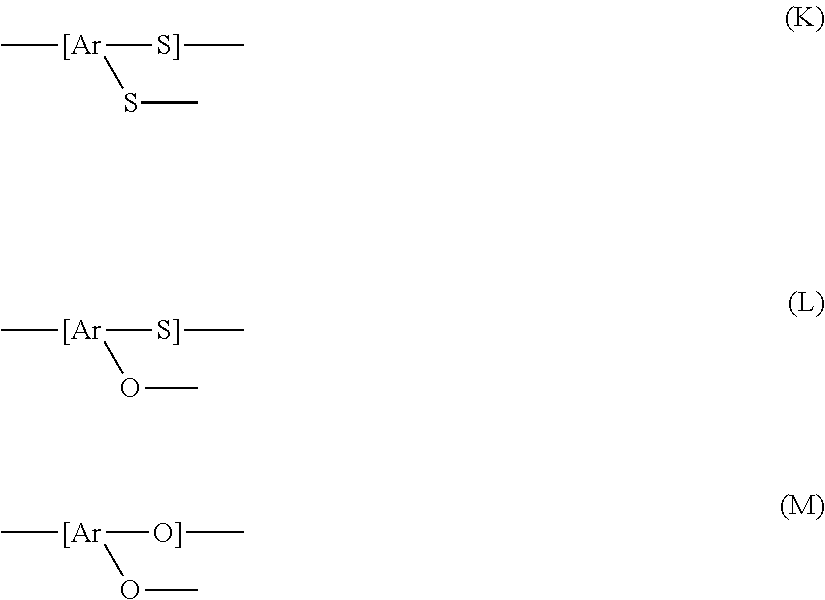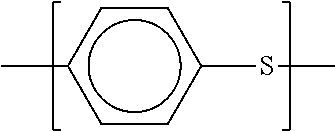Polyarylene sulfide and method for producing the same
a technology of polyarylene sulfide and sulfide, which is applied in the field of polyarylene sulfide, can solve the problems of reducing production efficiency, increasing complexity of molded articles, and high melt flowability, and achieves low volatile component content, high melt flowability, and efficient production.
- Summary
- Abstract
- Description
- Claims
- Application Information
AI Technical Summary
Benefits of technology
Problems solved by technology
Method used
Image
Examples
example 1
[0119]A 70-liter autoclave equipped with a stirrer and a bottom stop valve was charged with 8.26 kg (70.00 mol) of 47.5% sodium hydrosulfide, 2.94 kg (70.63 mol) of 96% sodium hydroxide, 11.45 kg (115.50 mol) of N-methyl-2-pyrrolidone (NMP), and 5.50 kg of ion exchanged water, and gradually heated to 225° C. at atmospheric pressure under nitrogen over about 3 hours. When 9.82 kg of water and 0.28 kg of NMP were distilled, the heating was terminated to start cooling. At this point, the amount of water remained in the system per mol of an alkali metal hydrosulfide charged was 1.01 mol including the water consumed by hydrolysis of NMP. The amount of scattered hydrogen sulfide was 1.4 mol, and accordingly the sulfidizing agent in the system after the dehydration step was 68.6 mol. With the scattering of hydrogen sulfide, an additional 1.4 mol of sodium hydroxide was produced in the system.
[0120]Thereafter, the autoclave was cooled to 200° C., and the reaction vessel was hermetically sea...
example 2
[0124]The same operation as in Example 1 was repeated except that the reaction was carried out at a constant temperature of 238° C. in Step 1 for 128 minutes. T1 was 188 minutes, and T1a was 150 minutes. The conversion ratio of p-DCB was 94.5%.
example 3
[0125]The same operation as in Example 1 was repeated except that Step 1 and Step 2 were carried out under the reaction conditions below.[0126] The temperature was raised from 200° C. to 230° C. at 0.8° C. / min over 38 minutes, and continuously the temperature was raised from 230° C. to 238° C. at 0.6° C. / min over 13 minutes. After the reaction was carried out at a constant temperature of 238° C. for 83 minutes, the temperature was raised from 238° C. to 245° C. at 0.8° C. / min over 9 minutes. T1 was 143 minutes, and T1a was 105 minutes. The conversion ratio of p-DCB was 90%.[0127] Following Step 1, the temperature was raised from 245° C. to 255° C. at 0.8° C. / min over 12 minutes, and then the reaction was carried out at a constant temperature of 255° C. for 25 minutes. T2 was 37 minutes.
PUM
| Property | Measurement | Unit |
|---|---|---|
| temperature | aaaaa | aaaaa |
| temperature | aaaaa | aaaaa |
| temperature | aaaaa | aaaaa |
Abstract
Description
Claims
Application Information
 Login to View More
Login to View More - R&D
- Intellectual Property
- Life Sciences
- Materials
- Tech Scout
- Unparalleled Data Quality
- Higher Quality Content
- 60% Fewer Hallucinations
Browse by: Latest US Patents, China's latest patents, Technical Efficacy Thesaurus, Application Domain, Technology Topic, Popular Technical Reports.
© 2025 PatSnap. All rights reserved.Legal|Privacy policy|Modern Slavery Act Transparency Statement|Sitemap|About US| Contact US: help@patsnap.com



